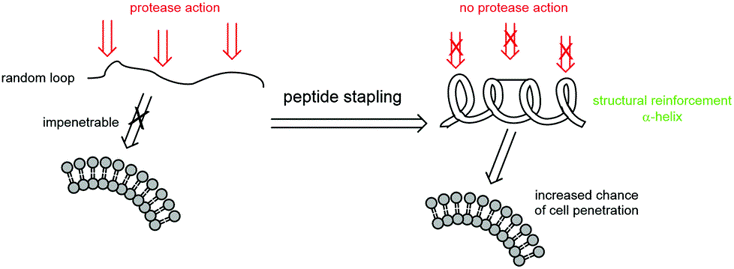
An expansion phase IIa cohort in PTCL opened in August 2016 using 3.1 mg/kg (arm A) and is currently enrolling. Conclusions: ALRN-6924 was well tolerated and demonstrated intriguing anti-tumor activity in this first-in-human phase I trial. 9 pts remain on treatment post data cutoff including 3 pts exceeding 1 year of treatment. In WT TP53 pts who initiated ALRN-6924 at ≥0.8 mg/kg, DCR was 57%. Two ,-disubstituted residues bearing olefin side chains of varying lengths are introduced into the peptide -helix, followed by a ruthenium-catalysed ring-closing metathesis reaction to form the staple across one or two -helical turns (Fig. In 55 pts evaluable for efficacy, disease control rate (DCR) was 45%, including 2 CR (Peripheral T-cell Lymphoma, Merkel Cell Carcinoma), 2 PRs (Colorectal Cancer, Liposarcoma) and 21 pts with SD. The hydrocarbon stapling technique combines two -helix stabilisation strategies, namely ,-disubstitution and macrocyclic bridge formation. The RP2D was determined to be at MTD: 3.1 mg/kg QW for 3 wks every 28 days. Infusion-related reactions were seen in 7 pts, with 3 treatment discontinuations. DLTs were G3 fatigue at 3.1 mg/kg, and G3 hypotension, G3 alkaline phosphatase elevation, G3 anemia and G4 neutropenia at 4.4 mg/kg all in 5 pts in arm A.

Treatment-related AEs seen in 96% of pts were primarily grade 1 and 2 most frequent were GI side effects, fatigue, anemia, and headache. ALRN-6924 showed a t 1/2 of 5.5 hours, dose-dependent PK, and an increase in serum macrophage inhibitory cytokine-1. For achieving efficient targeting of the PPI, amino acid side chains are often stapled together, resulting in the rigidification of these peptides. Pts received a median of 2 (1-19) cycles in arm A and 3 (1-19) cycles in arm B. Results: As of Dec 2016, 69 pts were enrolled with median age 61 yrs (25-78). Pts received ALRN-6924 IV once weekly for 3 consecutive wks on a 28-day cycle (arm A), or 2/wk for 2 consecutive wks on a 21-day cycle (arm B).


on the available stapled peptide high-resolution structures in the. Methods: The study evaluated safety, PK, PD and anti-tumor effects of ALRN-6924 in patients (pts) with advanced solid tumors or lymphomas in a standard 3+3 design. Eukaryotic translation initiation factor 4E (eIF4E) has emerged as a promising cancer therapeutic target due to its role in the initiation. A novel class -hydrocarbon-stapled -helical peptides that are synthetic mini. For TP53 wild-type (WT) tumors, pharmacological disruption of this interaction offers a means to restore p53-dependent cell cycle arrest and apoptosis, resulting in antitumor efficacy via a novel mechanism. Background: ALRN-6924 is a cell-penetrating stapled alpha-helical peptide designed to equipotently disrupt the interaction between the p53 tumor suppressor protein and its endogenous inhibitors, murine double minute X (MDMX) and 2 (MDM2).


 0 kommentar(er)
0 kommentar(er)
